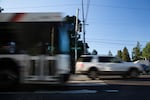Kim Stone’s son did everything right.
It was October 2013. Joe Stone was headed from his family's East Portland home to his mom's office downtown. He was 25 and going back to school. He wanted Stone's help in filling out a financial aid package, but his car was in the shop, so he walked out to Southeast Division Street to catch a bus.
“He needed to cross the street to get on the bus,” Kim Stone said recently. “So instead of crossing at 157th, Joe walked a block down to where there was a crosswalk.”
Division Street is five lanes near the Stones' home: two lanes going east, two going west, one in the middle for turns. The car in the lane closest to the sidewalk stopped for him. Another car coming up behind it did not.
Instead, the driver switched lanes.
Related: Portland Approves 20 Mph Speed Limit In Residential Zones
“He hit Joe in the crosswalk going 36 miles an hour,” Kim Stone said. “Joe was like maybe two steps from the median, the center median, and it threw him 71 feet.”
Over the past decade, 129 people have been seriously injured and 19 people have been killed on Division Street. That list includes Joe Stone.
Out where Portland and Gresham meet, Division Street is big and straight with a mishmash of zoning. It also has unprotected bike lanes, on-street parking and a population more likely to rely on mass transit than wealthier parts of the metro area. This cluttered combination makes Division, by almost every statistical gauge, among the most dangerous streets in the entire state of Oregon.
"It feels like so many things happening at the same time: Cars are there, people are walking, it feels like a rush, rushing," said Lisha Shrestha, executive director of the Division Midway Alliance, a nonprofit that works to build community in East Portland.
She commutes by mass transit and walks across Division Street at 122nd Avenue every day.
“I try to have eye contact with the drivers whenever I see they are turning around or driving. I try to look at them like, ‘Are they seeing me?’” she said. “I don’t just rely on the walk signal. You can’t do that.”

Cars and a TriMet bus drive down Southeast Division Street at 157th Avenue in Portland, Oregon, Wednesday, July 11, 2018.
Bradley W. Parks / OPB
Like leaders in many cities around the world, Portland is trying to combat that chaos with Vision Zero. It's an overarching philosophy of transportation planning that began in Sweden and says no loss of life on the roads is acceptable.
One of the first big projects city leaders embraced as part of Vision Zero was fixing outer Division and a set of problems that are common among a certain era of urban — or really, suburban — development in the United States.
“What we know is four- and five-lane arterials that are kind of a typical American suburban-style street is highly problematic for safety,” said Dana Dickman, with the Portland Bureau of Transportation. “They are designed in a way that when people are using them, they're driving at speeds that, if there is a mistake, it may be fatal.”
Years ago, Dickman and her colleagues usually dealt with road safety problems on essentially a case-by-case basis: You have a dangerous intersection, you add a stoplight or a crosswalk. Problem solved, maybe.
In the era of Vision Zero, traffic planners and engineers are taking a more numbers-driven, holistic approach to iffy roads.
“We pulled all the data for Division and analyzed the corridor to determine what the root cause of all these crashes are. When we looked at the data we found it's really this street design,” said Elizabeth Mahon, the city’s Outer Division project manager. “… The behavior there is similar to driving on a highway or freeway: It's open, and there are no messages being sent to reduce your speed or telling the driver that they would need to slow down.”
The answer, then, is rebuilding a street like Division so that when drivers do make mistakes, they're the kind that might raise your insurance bill but won't end a life.
Changes To Division Street

The city has already lowered the speed limit and added more red-light cameras to speed reader boards to show drivers just how fast they’re going.
More obvious changes are coming: More sidewalks, more streetlights, more crosswalks. A tree-lined raised center median. Separated bike lanes. Limits on where drivers can turn onto Division from cross streets.
At first glance, it might seem counter-intuitive: To make the street safer, they’re making it feel more cramped.
“By visually narrowing that roadway, we think drivers will actually get closer to that posted 30 mph speed limit,” Mahon said. “Right now, it’s easy to lose track of just how fast you’re going. These kinds of changes really narrow your focus so you have to pay more attention.”
Related: Traffic Deaths In Portland Up, Despite Vision Zero Efforts
The data, that hallmark of Vision Zero, shows some progress. Speeding, for example, is down. And yet, people are still dying on Division — two pedestrians so far in the first half of 2018.
Kim Stone still lives just off Division, and she thinks of her son every time.
“The feelings come back, yeah. I don’t flashback, but it’s more ‘Why more?’” she said. “Why? Why did there have to be more?”
The answer isn’t exactly consoling: It took generations for Division and suburban-style streets like it to get this bad. It will take at least a few more years to fix them.